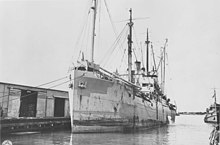SS Cynthia Olson
 Sinking of SS Cynthia Olson; photograph taken by Saburo Hayashi, a crew member of the Japanese submarine I-26.
| |
| History | |
|---|---|
| Name |
|
| Operator |
|
| Port of registry | |
| Builder | Manitowoc Shipbuilding Company, Manitowoc, Wisconsin |
| Yard number | 100 |
| Launched | November 30, 1918 |
| Out of service | December 7, 1941 |
| Identification |
|
| Fate | Sunk by Japanese submarine I-26 about 1,200 miles west of Seattle on December 7, 1941 |
| General characteristics | |
| Type | Cargo ship |
| Tonnage | |
| Length | 250 ft 5 in (76.3 m) registered length |
| Beam | 43 ft 7 in (13.3 m) |
| Depth | 20 ft 1 in (6.1 m) |
| Installed power | 1250 i.h.p. |
| Propulsion | 1 triple expansion steam engine , 2 boilers, 1 screw |
| Speed | 10 knots[1] |
| Crew | 35 |

SS Cynthia Olson was a
US Army to transport supplies to Hawaii. While in passage between Tacoma, Washington and Honolulu on December 7, she was intercepted by the Japanese submarine I-26, which sank her with gunfire. Although the commander of the submarine ensured that all of the crew had escaped into boats, none of them were ever found. Cynthia Olson was the first United States Merchant Marine vessel to be sunk after the entry of the United States into World War II
.
Construction
SS Coquina was ordered by the
prefabricated steel sections, was able to be launched on November 30.[2] The ship was one of nine Emergency Fleet Corporation Design 1044 hulls known as "Laker, Manitowoc Type" ordered from the Manitowoc Shipbuilding Company in Manitowoc, Wisconsin. The yard is known to have completed six hulls with Coquina, yard hull number 100, being completed in April 1919 assigned official number 217871 and signal letters LQRK.[3][4] Ship's characteristics were 2,153 GRT, changed in the 1920 register to 2,140 GRT, 250 ft 5 in (76.3 m) registered length, 43 ft 7 in (13.3 m) beam with a depth of 20 ft 1 in (6.1 m).[4][5][6]
Service
Hostilities having ended with the
Sinking
On December 6, 1941, SS Cynthia Olson was in the Pacific about midway on the
distress call stating that they were being attacked by a submarine; this was received by the American liner, SS Lurline, which was a considerable distance away bound for San Francisco.[11]
Meanwhile, 18 shells had failed to sink the Cynthia Olson, so Yokota dived and fired a second torpedo without a result. Surfacing again, a further 29 shells were fired into the ship,Infamy Speech.[13]
See also
- USS Stratford (AP-41)sister ship
- USS Gemini (AP-75) sister ship
References
- ^ a b Allen, Tony (April 28, 2008). "SS Cynthia Olson (+1941)". www.wrecksite.eu. The Wrecksite. Retrieved May 7, 2020.
- ^ ISBN 978-0306825033. Chapter 1
- ^ a b McKellar, Norman L. "Steel Shipbuilding under the U. S. Shipping Board, 1917-1921, Contract Steel Ships, Part IV" (PDF). Steel Shipbuilding under the U. S. Shipping Board, 1917-1921. ShipScribe. p. 233. Retrieved 12 May 2020.
- ^ a b Fifty Second Annual List of Merchant Vessels of the United States, Year ended June 30, 1920. Washington, D.C.: Department of Commerce and Labor, Bureau of Navigation. 1920. p. 78. Retrieved 12 May 2020.
- ^ Fifty First Annual List of Merchant Vessels of the United States, Year ended June 30, 1919. Washington, D.C.: Department of Commerce and Labor, Bureau of Navigation. 1919. p. 78. Retrieved 12 May 2020.
- ^ a b Historical Collections of the Great Lakes. "COQUINA". Bowling Green State University. Retrieved 12 May 2020.
- LCCN 87015514.
- ^ Priolo, Gary P. "USAT Cynthia Olson". www.navsource.org. NavSource Naval History. Retrieved 7 May 2020.
- ISBN 978-0517066584.
- ^ a b Prange 1991, p. 89
- ^ ISBN 978-1410494733.
- ^ "Cynthia Olson". navylog.navymemorial.org. United States Navy Memorial. Retrieved May 7, 2020.
- ^ Harding 2016, p. 71
